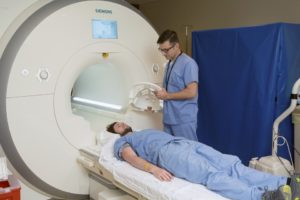How long do MRIs take?
Magnetic resonance imaging scans are used as an advanced diagnostic procedure to determine the cause of various symptoms and the exact location of conditions such as herniated discs, or spinal stenosis. The machine usually encompasses the entire body in a circular tube and performs the scan as you lay down in a flat bed, though there are open MRI machines that have an open side. The scan length depends on the area of the scan and how many images are to be taken for diagnosis, so the range is generally between 15 minutes and 90 minutes.
Can you eat before an MRI?
If you’re getting only an MRI scan done on that day you will be able to eat, drink, and take normal medications unless your doctor specifies otherwise. If you have a surgery the same day as the MRI it’s likely you will be advised not to eat 8 hours before the procedure. Though depending on the location of the scan you may be asked not to eat or drink 4 hours before an MRI, and to not drink a large amount of water beforehand. Your doctor should advise you specific instructions for your MRI scan, so just follow them closely as you go through the process.

MRI Dyes
MRI with contrast is a way to make MRI scans more accurate. Contrast agents containing a metal called gadolinium which interact with the magnetic field coming from the MRI, which helps identify diseases. MRI contrasts come in a many types that are crafted for specific purposes such as being organ specific, staying in the circulatory system, or targeting tumors. MRI contrasts are safe and have little to no side effects, and if they do happen they resolve without treatment. In very rare circumstances, in people with specific disorders such as kidney dysfunction, there may be more severe side effects or complications. The contrast when issued through an intravenous injection has possible side effects include a cold sensation, headache, nausea, dizziness, or coughing.
In most cases MRI is done without contrast, and is only used for specific purposes when your doctor deems it necessary. For things like a work related injury, sport injury, or back pain a contrast will likely not be called for.
What to wear for an MRI?
It’s important to remove all clothing with any metal in it or jewelry, and you will be provided metal free clothing such a gown, shorts or pants. 100% cotton clothing is safe for an MRI, as some athletic or other types of clothing contain metallic fibers, which will react to the MRI’s magnetic field. These fibers can move and heat up rapidly, and can cause light burns, so it’s important to wear the appropriate clothing during an MRI scan. Make sure to wear clothing without metal zippers or buttons, and avoid bras with underwire.
MRI Procedure
Along with clothing, you should alert your doctor if you have an artificial heart valve, pacemaker, any kind of implants, shrapnel or bullet wounds, a vascular stent, or dental implants. As you can tell, putting metal within an MRI machine isn’t a good idea since it’s a strong magnet, so if you have any metallic implants your doctor can adjust your exam to fit your situation.
Before the MRI you will change into a hospital gown if needed, and the technician will check your weight, height, heart rate, temperature and blood pressure. Once everything is ready with the machine you’ll lay in the MRI flatbed which will slide in position so that the appropriate location is targeted. You can enter head or feet first depending on the part of the body being scanned. A radiographer will be in a separate room operating the computer controlling the MRI as to keep the computer away from the magnetic field being created. Though you can talk to the radiographer through an intercom, and they will be able to see you through a monitor. Friends or family can stay with you during the scan, though they’ll need to be asked about metallic implants and follow the same guidelines.
For the sake of image clarity the part of the body being scanned should remain still throughout the duration of the scan, otherwise the image might come out blurred. Single scans can take seconds or 3 to 4 minutes, but the entire process will range from 15 minutes to 90 minutes depending on how many images are being taken. The MRI scanner usually makes loud noises during the process, which is the result of the electric current moving through the scanner coils as its being turned on and off. You will be provided with earplugs to help with the noise, or listen to music through provided headphones.
After an MRI Scan
MRI scans are an outpatient procedure, which means you can go home and resume normal activities right away. Unless you’ve had a sedative, in which case a friend or relative will need to stay with you for the first 24 hours and drive you home. It isn’t safe to drive for 24 hours after receiving a sedative. After the MRI scan is done your results need to be examined by a radiologist and the information relayed back to your doctor.
How long for MRI results?
The images created by the MRI scan are usually given to you on a disc immediately after the scan is complete, though the results need to be read by the radiologist and your doctor. Because the MRI results need to be studied by the radiologist who will create a report that is sent to your doctor the results aren’t available immediately. Your doctor will receive the report and then discuss the results with you, which might take a week or two unless they’re needed quickly. MRI scans are very helpful for spinal conditions like a herniated disc or spinal stenosis.


